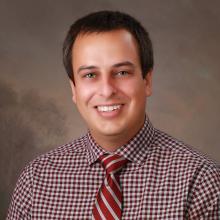From Small Town to Big 10: Reflections from the Past to Inform the Future

Forty miles north of Green Bay, Wisconsin, U.S. Highway 141 ends its freeway segment and becomes a two-lane highway, very much like the classic two-lane highways that dotted the American landscape in an era before the interstate system existed. The freeway ends just north of the 45th parallel. If one has ventured this far north, they are officially closer to the North Pole than they are to the equator.
Another 85 miles north of that lies my hometown of Crystal Falls, Michigan. With a population of around 2,000, Crystal Falls takes its name from the waterfalls and rapids of the Paint River, which have been lost to a hydroelectric power dam since the late 1800s. Most of my ancestors arrived in this corner of Michigan’s Upper Peninsula from Finland during one of the European immigration waves of the early 1900s. If they were searching for a climate like their snowy homeland, they certainly found it.
My memories of childhood in Crystal Falls are positive. We never felt the need to lock the doors to our house. In winter, my parents often left their vehicles running in the parking lot of the grocery store without any real concern. And the local school consisted of a single campus where all kids ages 4 to 18 attended class together. Crystal Falls was and still is the quintessential American small town where everyone knows everyone. Isolated from the hustle and bustle of any major city, in many ways it is also isolated from the world around it. This is an unlikely place for one’s international education journey to start, but it is indeed where mine started.
Widening Horizons
I first developed an interest in French because the mother of an elementary school friend had studied it in college. My friend often treated her like his personal translator, asking how to say individual words or the silliest of phrases in French. Neither of my parents could speak another language, and, for that matter, neither of them had completed college. As a result, I found it fascinating that someone I knew could speak another language. Little did I know—or, perhaps more accurately, little did I appreciate—that a few members of my own family could speak some Finnish.
Luckily for this budding interest, the one language offered at my school was French. My French teacher, Madame Trask, whom we simply called “Madame,” was a wonder in her own right. Her methodology involved frequent singing, often with an unenthusiastic choir, and guitar playing, featuring songs such as “Aux Champs-Élysées” and, during the holiday season, “Un Flambeau, Jeannette, Isabelle.”
My junior year of high school, Madame offered a trip to France, like she did every two years; my sister had participated four years prior. I signed up without hesitation, though only later did I learn how much of a financial sacrifice this was for my mother. The itinerary was 14 days in length, if I remember correctly, and involved stops in Paris, Aix-en-Provence, Montpellier, Marseille, Nice, and various other locations across the south of France. I also spent five days with a host family. When I met them for the first time, I vividly remember Madame telling them not to let me speak English.
Without my small-town roots, without my friend’s mother, without Madame, without French, without all of the collective experiences that I cannot even begin to dissect, my path would look very different.
I would not know it then, but all of these ingredients were working together to form a cohesive recipe, one that would encourage me to continue studying French and, later, study abroad. This would eventually nudge me into teaching English and toward a master’s degree, which would in turn open the door to the world of international student and scholar services. This is where I find myself today, humbled by my affiliation with the University of Michigan, a top-tier public research institution, honored to have been asked to share my thoughts here. Without my small-town roots, without my friend’s mother, without Madame, without French, without all of the collective experiences that I cannot even begin to dissect, my path would look very different.
Trusting in the Fruits of Our Labor
As I write this, I realize how lucky I am to have had these early opportunities, but I feel conflicted that I have to consider myself lucky. My story of meaningful multicultural experiences in a small town in the United States should not be unique, yet it is. Indeed, most of our peers across the globe from towns big and small can readily tell their childhood stories in at least two languages. In a way, my experience sheds light on some of the work we have yet to do.
One such initiative with the potential for wide impact is the adoption of a national strategy for international education. NAFSA has already done great work in this space, expertly articulating why this is needed and what it could accomplish. I am particularly grateful that NAFSA’s position statement includes the need to increase foreign language instruction. I recommend reading more about this on the NAFSA website and advocating for this when possible.
My story of meaningful multicultural experiences in a small town in the United States should not be unique, yet it is.
This past summer, I was able to revisit Nice for the first time in nearly 20 years. There, I took a picture of myself against the backdrop of the sun setting behind the gentle peaks of the Alpes-Maritimes. I sent this picture to Madame with a note about how my life is better because of French and that I owed that to her. Her response was humble as much as it was appreciative and reciprocal.
This is where the power of our work is both clear and fuzzy at the same time. As we trudge through what can sometimes feel like a grind, much like I am sure Madame did when I was her student, it is not always easy to see the fruits of our labor. But our work does make a difference, even if those results are a note of thanks 20 years later from a former student. In the next 75 years and beyond, with our continued commitment, we can and will play an important role in shaping a brighter and more compassionate future for all, just like Madame and so many others did for me. •
Tyler Morkin is SEVIS coordinator at the University of Michigan and serves as Academy coach for NAFSA's Region V.
About International Educator
International Educator is NAFSA’s flagship publication and has been published continually since 1990. As a record of the association and the field of international education, IE includes articles on a variety of topics, trends, and issues facing NAFSA members and their work.
From in-depth features to interviews with thought leaders and columns tailored to NAFSA’s knowledge communities, IE provides must-read context and analysis to those working around the globe to advance international education and exchange.
About NAFSA
NAFSA: Association of International Educators is the world's largest nonprofit association dedicated to international education and exchange. NAFSA serves the needs of more than 10,000 members and international educators worldwide at more than 3,500 institutions, in over 150 countries.
NAFSA membership provides you with unmatched access to best-in-class programs, critical updates, and resources to professionalize your practice. Members gain unrivaled opportunities to partner with experienced international education leaders.















